Table of contents
- Basics: This is how silencers are made Visiting the Shark company
- Step 1
- Step 2
- Step 3
- Step 4
- Step 5
- Step 6
- Step 7
- Step 8
- Step 9
- Step 10
- Step 11
- Step 12
- Step 13
- Step 14
- Step 15
- Step 16
- Step 17

archive
accesories
Exhaust & silencer
Basics: This is how silencers are made
Basics: This is how silencers are made
Visiting the Shark company
2Wheels at the Shark company in Soncino, northern Italy, observed which work steps are necessary before a new silencer sees the light of day.
07.09.2009
Silencers differ in two types: On the one hand, there are reflection dampers that dampen the sound through different chambers inside the system. On the other hand, there are absorption dampers, which cover around 95 percent of the market and where insulation wool wrapped around the inner pipe ensures the necessary noise reduction. 2Rader was shown the manufacturing process of the much more frequently used absorption models at Shark.
Around 20 zealous employees have ensured that around 15,000 final pots leave the company every year since 1981. No wonder – after all, adding an accessory damper is one of the most popular conversion measures on a motorcycle. Why? Quite simply: Most series systems are bulky, heavy and not exactly pretty. In addition, their sound often falls by the wayside. Almost all retrofit dampers from the accessories are slimmer, more delicate, appear sportier – also in terms of sound – are usually much lighter and cost less than the standard pot.
Step 1
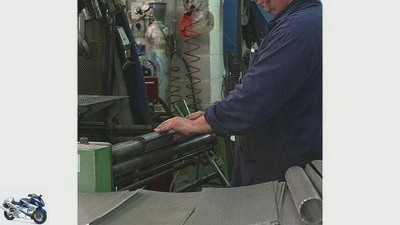
In the first step, huge perforated sheets made of stainless steel are first cut to the required size and then rolled into a tube on a machine.
Step 2

Lots of spot welds over the entire length of the perforated sheet ensure that the later inner tube always stays in shape.
Step 3

A short metal tube is welded into the exhaust end, which later serves as a guide for the dB absorber (also known as a flute).
Step 4
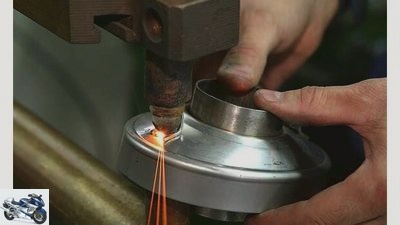
Two metal hooks are welded onto the front end cap towards the manifold, into which the safety springs are attached when the exhaust is installed.
Step 5
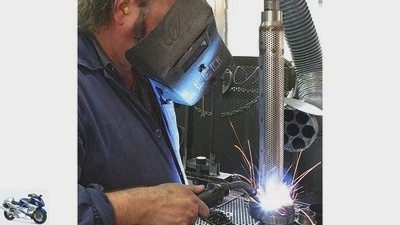
Now the front cap with the attached spring hooks is welded to the perforated inner tube.
Step 6
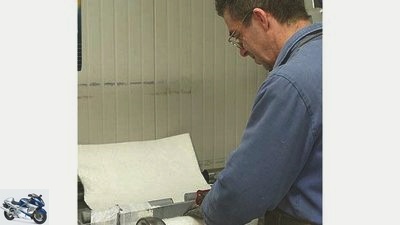
An employee wraps insulating material made of heat-resistant glass fiber material in several layers as tightly as possible around the perforated inner tube.
Step 7

After welding on the inner rear end cap, a narrow steel strut is inserted and welded. It will later serve as a fastening for the exhaust bracket.
Step 8
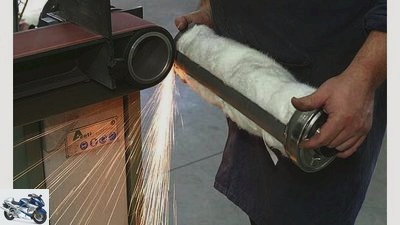
So that the outer shell made of aluminum, stainless steel, carbon or titanium can be pushed unhindered over the blank, the protruding weld seam must be ground off.
Step 9
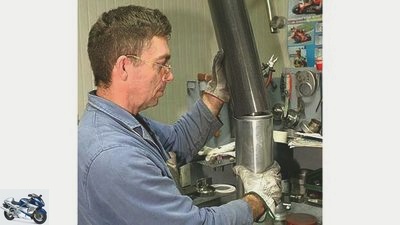
Before the carbon outer shell is pushed on, the blank is given a heat protection layer made of special textile and aluminum sheet.
Step 10
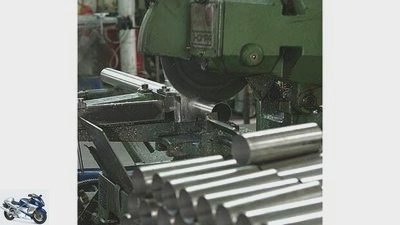
The visible end pipes protruding from the rear of the exhaust, which are welded to the outer cap, must be cut to the required length from bar material with a chop saw.
Step 11
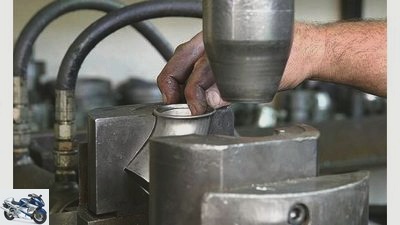
In several work steps, the end tube is bent and crimped on special presses. As a result, the pipe end not only looks pretty, it also no longer has any sharp-edged burrs.
Step 12
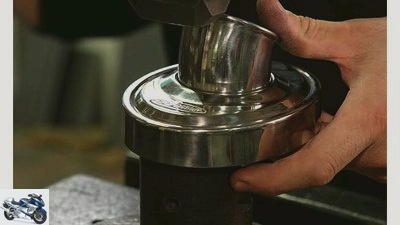
The end cap, which has already been welded to the bent end tube, is stamped with the brand logo and e-mark.
Step 13
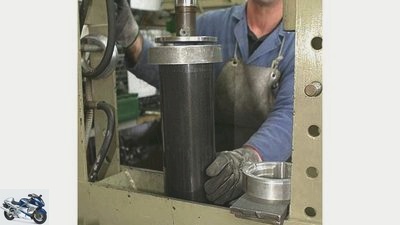
With machine power, the finished rear end cap is pressed over the outer shell of the silencer. In order not to damage the sensitive carbon shell, you need a sure instinct.
Step 14
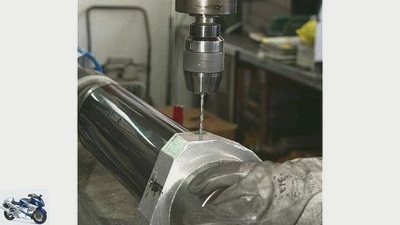
The almost finished silencers are placed in templates in order to drill the holes for the exhaust bracket and for all the rivets for the end caps and the brand logo.
Step 15
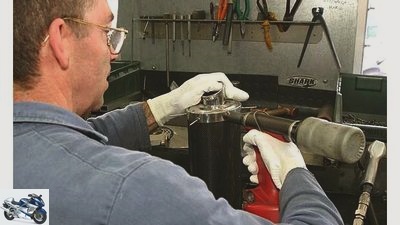
An assembly professional only needs a few seconds to rivet the end caps with the help of a tried and tested riveting gun. And the pot holds together.
Step 16
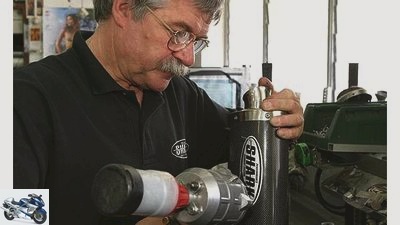
On the occasion of the 2Rader visit, the company boss insisted on attaching the company logo himself.
Step 17

Now insert the dB absorber and rivet it, and the silencer is ready. Finally, the shipping department cleans and polishes the pot, puts it in a suitable box and sends it to you.
Related articles
-
This is how it works: Adjust the spring base yourself
accesories landing gear & Spring elements This is how it works: Adjust the spring base yourself This is how it works: Adjust the spring base Adjust the…
-
12 silencers for the BMW R 1200 GS in the test
Lohse 41 pictures Lohse 1/41 3rd place: Hattech Dark Style The Hattech muffler not only gives the GS a powerful sound, but also scores with a…
-
Basics: what happens at top speed?
jkuenstle.de counselor workshop Basics: What happens at top speed? Basics: top speed What happens at top speed? At almost 300 kilometers an hour, the…
-
Swabian leather bag made from recycled station wagon
Swabian leather 18th pictures Julia Hammers 1/18 Developed out of necessity: The recycling product made from a cut up Swabian leather suit. Julia Hammers…
-
Arctos Ducati Panigale R: Made from a lot of carbon from Switzerland
Urs Schmid Zumbrunn Studio 10 pictures Urs Schmid Zumbrunn Studio 1/10 Panigale R as Ultraleggera from Arctos-Collektion from Switzerland. Price on…
-
LS2 FF805 Thunder helmet: FIM homologated made of carbon
LS2 10 pictures LS2 1/10 LS2 brings the new FF805 Thunder straight from the racetrack to the road. LS2 2/10 The one is homologated according to the old…
-
This is how it’s done: motorcycle helmets
Bilski 16 pictures Bilski 1/16 (8) The outer shells of the thermoplastic helmets are roughened by hand… Bilski 2/16 (12) The inner parts of the helmets…
-
Technical question about clutch discs made of aluminum
Cook counselor technology & future Technical question about clutch discs made of aluminum Technology question – what use are clutch friction plates made…
-
A comparison test of ten silencers for the Kawasaki Z 800
mps studio 30th pictures Lohse 1/30 Certification mark: If the exhaust is correctly marked (E-check digit plus four-digit numerical code, 5 or 9 circled…
-
Factory report: Shoei – Made in Japan
Lohse 9 pictures Lohse 1/9 Taking a break together: In the Iwate canteen, an eager kitchen crew takes care of the typical Japanese lunch. Lohse 2/9 Each…